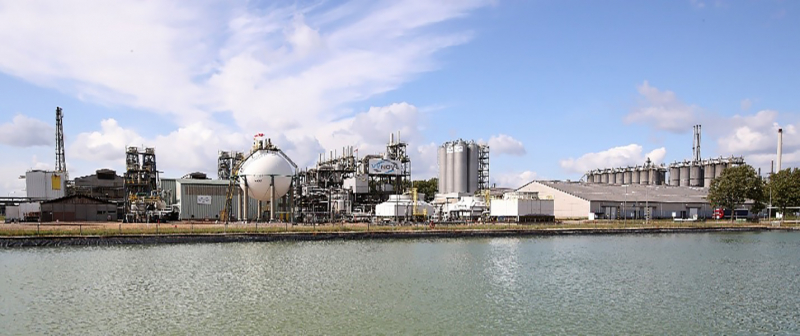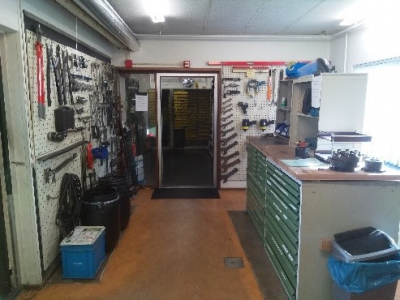The metamorphosis of a maintenance department
“I really regret that I could not work in such a workshop much earlier.” One of the E&I technicians at the Vynova location in Beek (NL) is speaking. He recently reorganized the workshop according to the 5S method, together with the colleagues in his team. He is proud that this is the reference now for other colleagues, who each approach their workplace in the same way.
This is just one of the many changes that have been made by employees in the past 12 months, to their own great satisfaction.

From reactive to planned maintenance
I am visiting my Stork colleague Ron Bezoen who has been guiding the organization here for over two years in realizing a true metamorphosis of the maintenance organization. It is remarkable what the people of Vynova Beek have achieved under his guidance since my last visit, now 12 months ago.
The spare parts warehouse seems to me to be really neat and orderly. The warehouse manager proudly says that now he is rarely approached because technicians cannot find the necessary articles. However, the warehouse manager indicates that there is still an MRO component (Maintenance, Repair and Operating supplies) in the program to optimize warehouse operation further.
In the coffee corner, my eye catches a giant poster with the roadmap of the entire program. The building blocks are shown in the order of realization on the various improvement axes. Colours indicate progress. I can imagine that this reminds everyone, whether closely involved, of the importance of the improvement program on a daily basis. Someone says: “Without this Asset Management program, our company might end up in difficult waters.”
A clear division of roles
I meet the work planner and the maintenance engineer. They share the same office space. This is not a coincidence, but the result of a conscious choice. It facilitates the spontaneous exchange of data and real collaboration between these two functions. A fundamental improvement was the clear definition of the workflow. It has been clearly agreed who will play which role in this. For example, there are now work preparators, a planner and a maintenance engineer who know precisely what is expected of them. So, they can work together better. This resulted in a lot more focus with each player so that everyone can evolve and become better at what he does.
 Ron Bezoen: The mechanics feel that very little has changed for them. This is an indication to me that the changes have apparently gone very smoothly for them. Because in reality, the life of the mechanics and the workshop manager is very different from a year ago.
Ron Bezoen: The mechanics feel that very little has changed for them. This is an indication to me that the changes have apparently gone very smoothly for them. Because in reality, the life of the mechanics and the workshop manager is very different from a year ago.
At that time, they spent 80% of their time on troubleshooting. If there was still some time left, they sometimes took preventive actions. Now, 80% of the work they do is prepared and scheduled. First, the work planners collect everything technicians need to carry out the work safely, qualitatively and efficiently.
The planners determine, among other things, which parts are needed, check whether they are in stock and order them if necessary. The work scheduler includes the work orders in the planning as soon as all necessary parts are available. One week before the planned execution, the warehouse manager collects the parts per work order in so-called kits. The week before implementation, the planned work is also discussed with the technicians. The technicians then check the prepared spare parts kits for each work order.
All this ensures that they can start and finish the planned work every day without wasting time. The main priority for the mechanics and the workshop manager is to get the work done according to schedule. The workshop manager takes the initiative to deploy contractor employees if the in-house technicians' capacity is insufficient. Breakdown maintenance is handled by a few technicians assigned to it. All this means that most technicians are rarely interrupted in their work due to urgent corrective maintenance.
The CMMS has been optimized
I note that the whole operation seems very self-evident at this point.
Ron Bezoen: Make no mistake! We have really been busy in the past few years. The organization did a lot of work to get this far. Employees familiar with the current state of the installation have updated the plant's tree structure again after ten years. As a result, all notifications (work requests) can now be linked to the correct TAG, and an accurate history of maintenance is currently being built up. Production, process engineer and maintenance have determined the criticality of all installation parts together. This information is available in the CMMS (Computerized Maintenance Management System - Asset management software) and is used by the operators in determining the priority of the work requests they create.
All operators are trained for this and are regularly instructed when the notifications' quality is not yet satisfactory. New notifications are jointly reviewed in the daily morning meeting. Requests that are incomplete or unclear are returned to the reporter. The stated priority is verified and only needs to be adjusted for 10% of the notifications. The CMMS now also facilitates that requests can be cancelled if there are reasons for this. This was simply not possible in the past. Naturally, the reporter is always informed about this – with the necessary arguments.
The CMMS (SAP-PM) has also been adapted in various ways to support the new way of working properly. The work planners, scheduler and maintenance engineer have all been trained and coached in their new role. And where we are now is not the end state. We continue to improve. In terms of work planning and scheduling, we have set up an improvement loop, in which the workshop manager and the technicians play an important role. We expect them to provide feedback on where both work planning and scheduling can improve further. The scheduler now works with a horizon of 2 weeks, but we are ready to start scheduling with a horizon of 13 weeks. There is now also a list of non-urgent fillers. This makes idle time for the technicians a thing of the past.
An improved reliability
The reliability engineer, recruited two years ago, adds to the conversation: In recent months, we have seen a clear downward trend in the number of hours of downtime per month. We are confident that we will achieve the target we have set ourselves within the allotted time. However, we are only at the beginning here. We have fully checked the existing maintenance plan based on the FMEA methodology (Failure Mode and Effect Analysis). All known failure risks and the associated mitigating measures are now centrally documented. A series of improvements have since been made to the existing maintenance plan, and gaps have been filled. But more importantly, we are now also increasingly succeeding in implementing the maintenance plan actually and punctually. We are not completely there yet, but we are getting better at this.
Ron Bezoen continues: We have now also taken the first steps in systematically improving reliability by learning from failures. This requires technicians to report properly, and preferably in a structured manner, after every malfunction. To this end, so-called SCRA codes have been determined for each type of equipment. These are used to classify Symptom, Cause, Remedy and Action in the CMMS for each failure. In any case, I also notice that people - also in production - increasingly have the reflex to look for the underlying cause after every disruption in production. This will help us take very targeted measures to prevent failures, for example, by systematically improving the maintenance plan. We have recently also started using a structured Root Cause Analysis method to determine the causes of the somewhat more complex failures with a high impact. Various disciplines are involved, including mechanics, so that no angle is overlooked.
The plant manager: “It is a team effort”
 We take time for a coffee, and the plant manager greets us: This program is really a team effort. It has also made us stronger as a team. During the first wave of COVID-19, we had a stagnation, maybe even a relapse. But it was remarkable how, through joint focus, we had eliminated the relapse within two weeks, and we were taking the next steps. For me, as a budget manager, it is a big improvement that we now budget and monitor maintenance costs in detail. This ensures that the costs are also more predictable; we have fewer surprises. I also notice that we make decisions much more risk-based. We are much more aware of the risks we take when we make decisions.
We take time for a coffee, and the plant manager greets us: This program is really a team effort. It has also made us stronger as a team. During the first wave of COVID-19, we had a stagnation, maybe even a relapse. But it was remarkable how, through joint focus, we had eliminated the relapse within two weeks, and we were taking the next steps. For me, as a budget manager, it is a big improvement that we now budget and monitor maintenance costs in detail. This ensures that the costs are also more predictable; we have fewer surprises. I also notice that we make decisions much more risk-based. We are much more aware of the risks we take when we make decisions.
We say goodbye, and I wish to come back in a year.
The plant manager: That would be nice, and I am confident that we will be very proud of what we have achieved by then.”